Travel and Tourism Sector
VerifiedAdded on 2023/04/03
|10
|2030
|61
AI Summary
This report explores the growth and impact of the travel and tourism sector on the economy, society, and environment. It discusses factors affecting tourism demand, strategies developed by TUI group to meet the demand, and positive and negative economic, social, and environmental impacts of tourism. The report also highlights the strategies implemented by TUI group to reduce the negative impact of tourism.
Contribute Materials
Your contribution can guide someone’s learning journey. Share your
documents today.
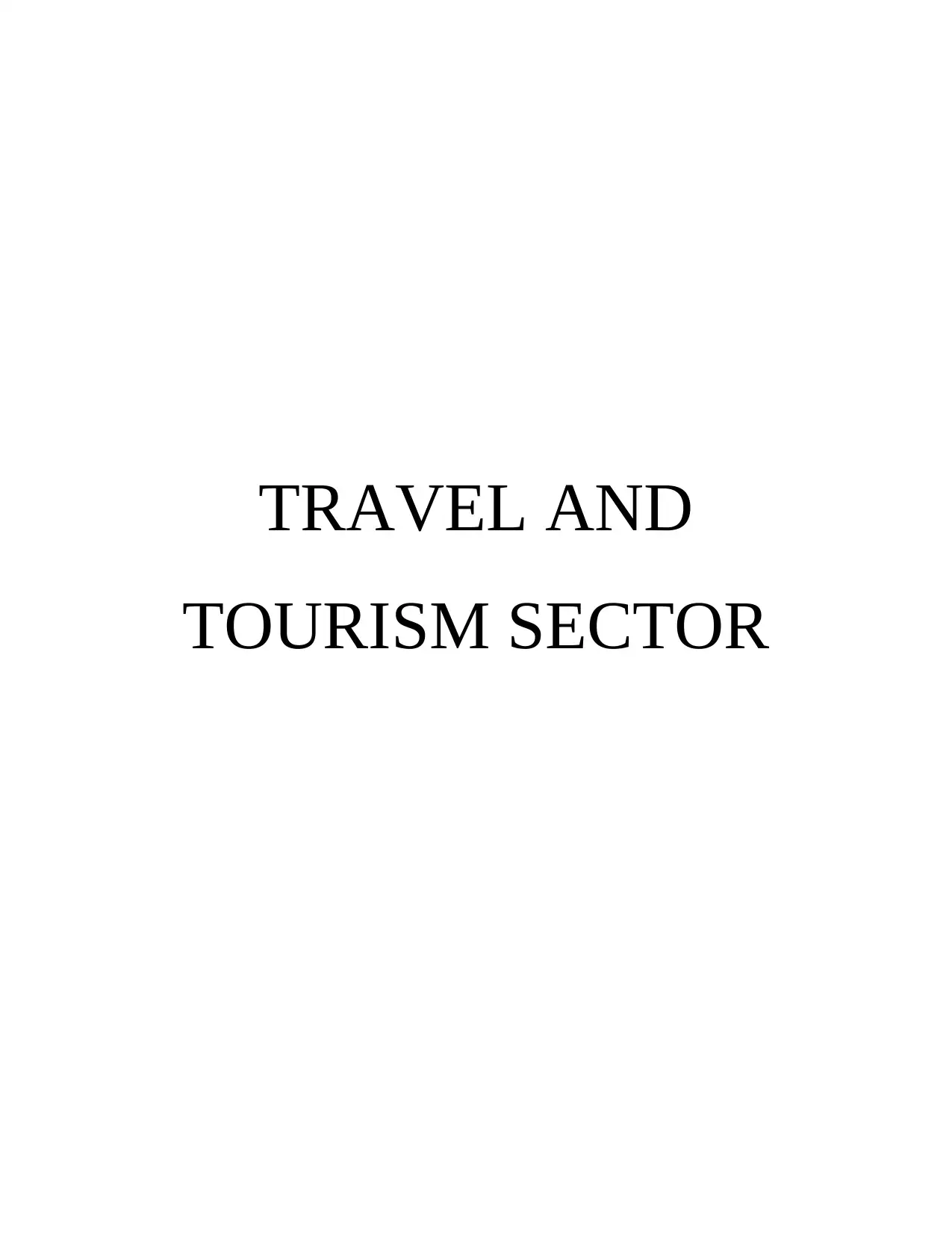
TRAVEL AND
TOURISM SECTOR
TOURISM SECTOR
Secure Best Marks with AI Grader
Need help grading? Try our AI Grader for instant feedback on your assignments.
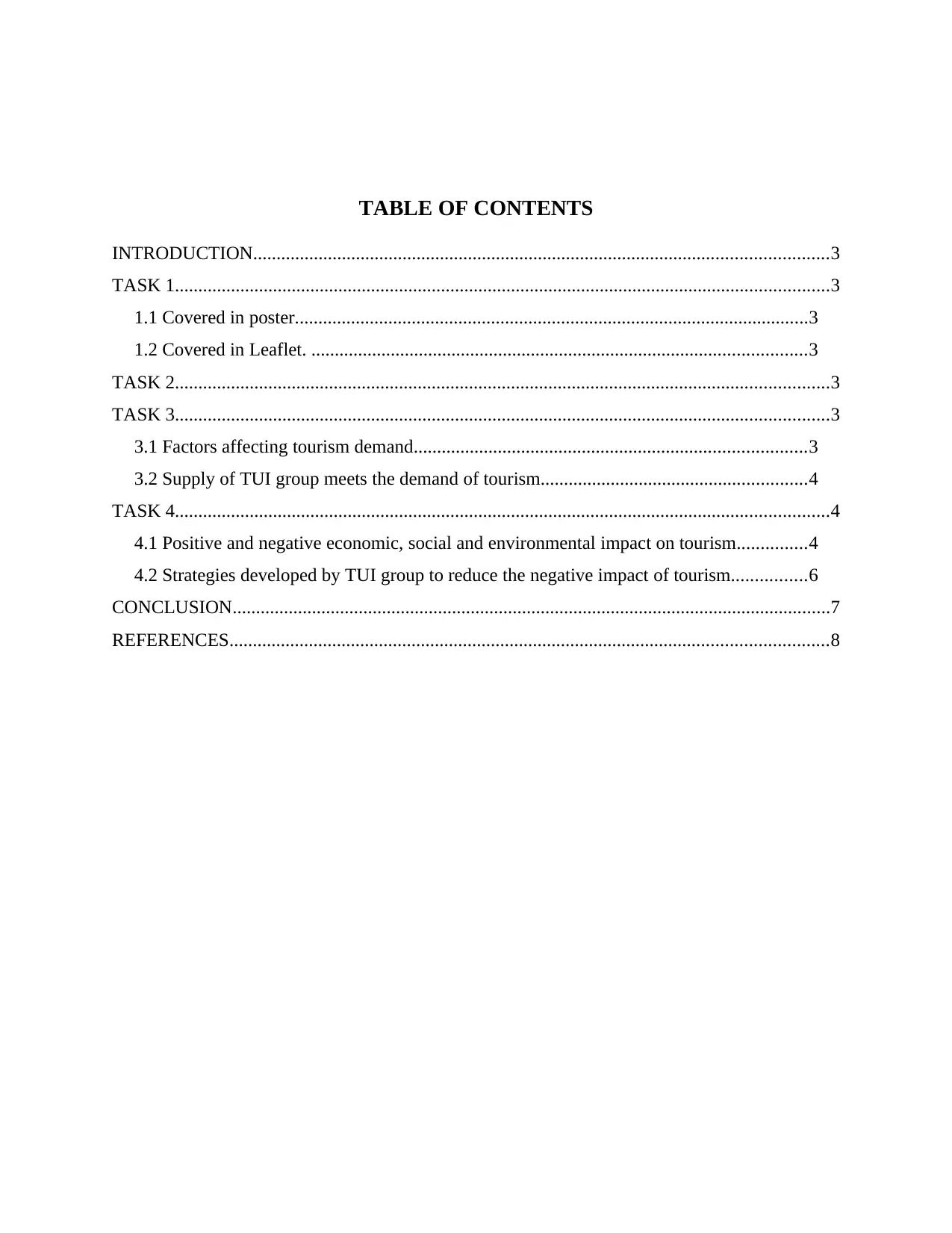
TABLE OF CONTENTS
INTRODUCTION...........................................................................................................................3
TASK 1............................................................................................................................................3
1.1 Covered in poster..............................................................................................................3
1.2 Covered in Leaflet. ..........................................................................................................3
TASK 2............................................................................................................................................3
TASK 3............................................................................................................................................3
3.1 Factors affecting tourism demand....................................................................................3
3.2 Supply of TUI group meets the demand of tourism.........................................................4
TASK 4............................................................................................................................................4
4.1 Positive and negative economic, social and environmental impact on tourism...............4
4.2 Strategies developed by TUI group to reduce the negative impact of tourism................6
CONCLUSION................................................................................................................................7
REFERENCES................................................................................................................................8
INTRODUCTION...........................................................................................................................3
TASK 1............................................................................................................................................3
1.1 Covered in poster..............................................................................................................3
1.2 Covered in Leaflet. ..........................................................................................................3
TASK 2............................................................................................................................................3
TASK 3............................................................................................................................................3
3.1 Factors affecting tourism demand....................................................................................3
3.2 Supply of TUI group meets the demand of tourism.........................................................4
TASK 4............................................................................................................................................4
4.1 Positive and negative economic, social and environmental impact on tourism...............4
4.2 Strategies developed by TUI group to reduce the negative impact of tourism................6
CONCLUSION................................................................................................................................7
REFERENCES................................................................................................................................8
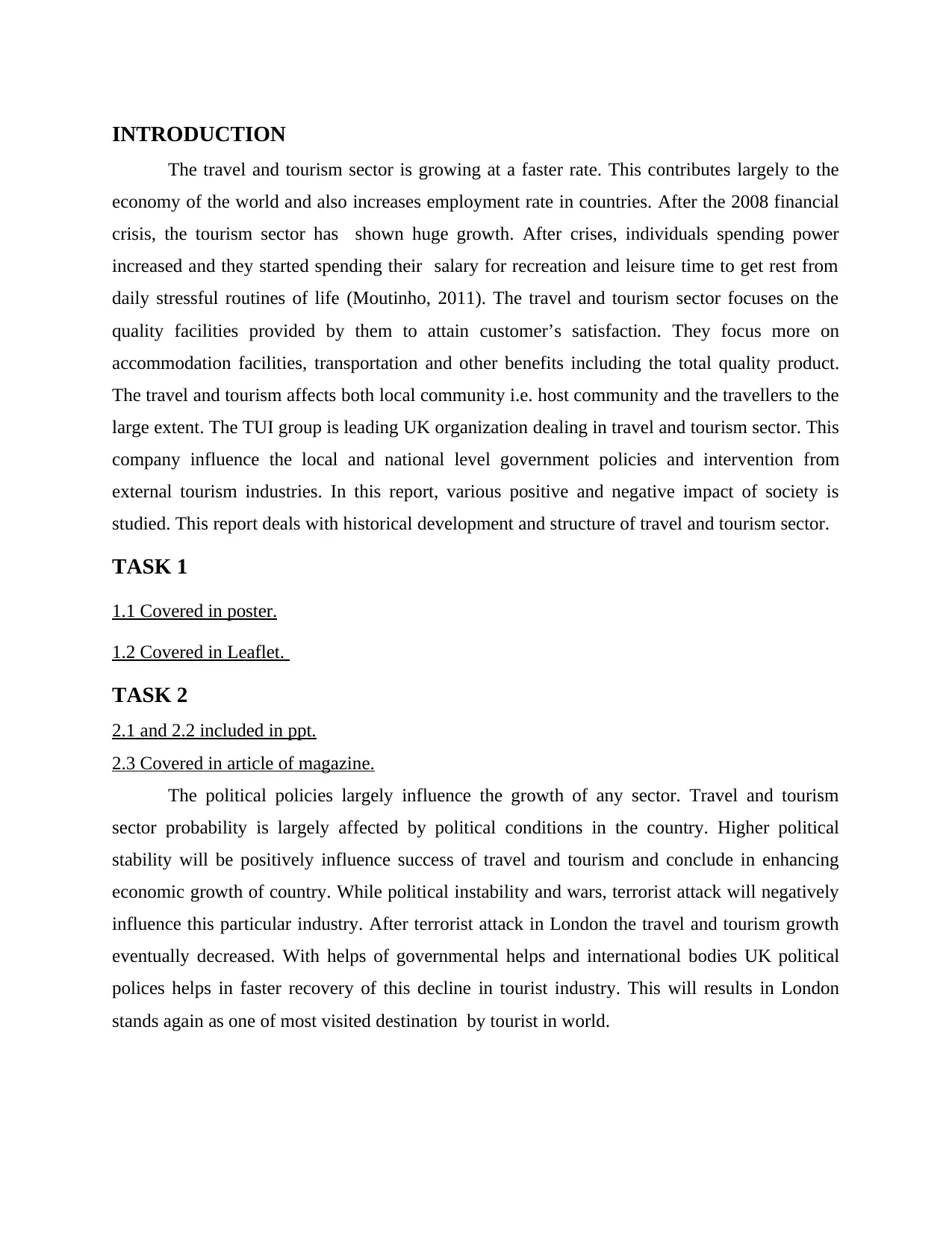
INTRODUCTION
The travel and tourism sector is growing at a faster rate. This contributes largely to the
economy of the world and also increases employment rate in countries. After the 2008 financial
crisis, the tourism sector has shown huge growth. After crises, individuals spending power
increased and they started spending their salary for recreation and leisure time to get rest from
daily stressful routines of life (Moutinho, 2011). The travel and tourism sector focuses on the
quality facilities provided by them to attain customer’s satisfaction. They focus more on
accommodation facilities, transportation and other benefits including the total quality product.
The travel and tourism affects both local community i.e. host community and the travellers to the
large extent. The TUI group is leading UK organization dealing in travel and tourism sector. This
company influence the local and national level government policies and intervention from
external tourism industries. In this report, various positive and negative impact of society is
studied. This report deals with historical development and structure of travel and tourism sector.
TASK 1
1.1 Covered in poster.
1.2 Covered in Leaflet.
TASK 2
2.1 and 2.2 included in ppt.
2.3 Covered in article of magazine.
The political policies largely influence the growth of any sector. Travel and tourism
sector probability is largely affected by political conditions in the country. Higher political
stability will be positively influence success of travel and tourism and conclude in enhancing
economic growth of country. While political instability and wars, terrorist attack will negatively
influence this particular industry. After terrorist attack in London the travel and tourism growth
eventually decreased. With helps of governmental helps and international bodies UK political
polices helps in faster recovery of this decline in tourist industry. This will results in London
stands again as one of most visited destination by tourist in world.
The travel and tourism sector is growing at a faster rate. This contributes largely to the
economy of the world and also increases employment rate in countries. After the 2008 financial
crisis, the tourism sector has shown huge growth. After crises, individuals spending power
increased and they started spending their salary for recreation and leisure time to get rest from
daily stressful routines of life (Moutinho, 2011). The travel and tourism sector focuses on the
quality facilities provided by them to attain customer’s satisfaction. They focus more on
accommodation facilities, transportation and other benefits including the total quality product.
The travel and tourism affects both local community i.e. host community and the travellers to the
large extent. The TUI group is leading UK organization dealing in travel and tourism sector. This
company influence the local and national level government policies and intervention from
external tourism industries. In this report, various positive and negative impact of society is
studied. This report deals with historical development and structure of travel and tourism sector.
TASK 1
1.1 Covered in poster.
1.2 Covered in Leaflet.
TASK 2
2.1 and 2.2 included in ppt.
2.3 Covered in article of magazine.
The political policies largely influence the growth of any sector. Travel and tourism
sector probability is largely affected by political conditions in the country. Higher political
stability will be positively influence success of travel and tourism and conclude in enhancing
economic growth of country. While political instability and wars, terrorist attack will negatively
influence this particular industry. After terrorist attack in London the travel and tourism growth
eventually decreased. With helps of governmental helps and international bodies UK political
polices helps in faster recovery of this decline in tourist industry. This will results in London
stands again as one of most visited destination by tourist in world.
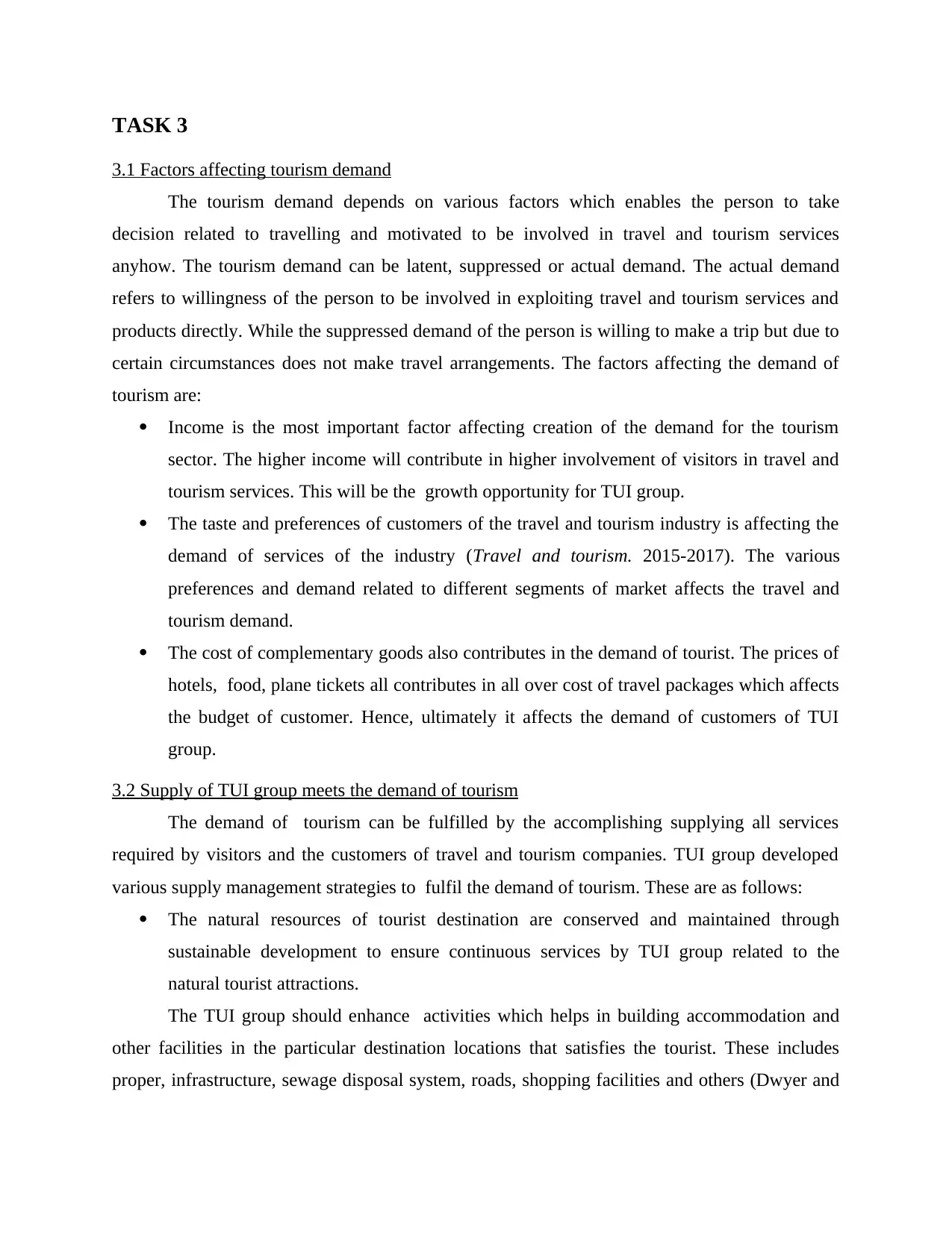
TASK 3
3.1 Factors affecting tourism demand
The tourism demand depends on various factors which enables the person to take
decision related to travelling and motivated to be involved in travel and tourism services
anyhow. The tourism demand can be latent, suppressed or actual demand. The actual demand
refers to willingness of the person to be involved in exploiting travel and tourism services and
products directly. While the suppressed demand of the person is willing to make a trip but due to
certain circumstances does not make travel arrangements. The factors affecting the demand of
tourism are:
Income is the most important factor affecting creation of the demand for the tourism
sector. The higher income will contribute in higher involvement of visitors in travel and
tourism services. This will be the growth opportunity for TUI group.
The taste and preferences of customers of the travel and tourism industry is affecting the
demand of services of the industry (Travel and tourism. 2015-2017). The various
preferences and demand related to different segments of market affects the travel and
tourism demand.
The cost of complementary goods also contributes in the demand of tourist. The prices of
hotels, food, plane tickets all contributes in all over cost of travel packages which affects
the budget of customer. Hence, ultimately it affects the demand of customers of TUI
group.
3.2 Supply of TUI group meets the demand of tourism
The demand of tourism can be fulfilled by the accomplishing supplying all services
required by visitors and the customers of travel and tourism companies. TUI group developed
various supply management strategies to fulfil the demand of tourism. These are as follows:
The natural resources of tourist destination are conserved and maintained through
sustainable development to ensure continuous services by TUI group related to the
natural tourist attractions.
The TUI group should enhance activities which helps in building accommodation and
other facilities in the particular destination locations that satisfies the tourist. These includes
proper, infrastructure, sewage disposal system, roads, shopping facilities and others (Dwyer and
3.1 Factors affecting tourism demand
The tourism demand depends on various factors which enables the person to take
decision related to travelling and motivated to be involved in travel and tourism services
anyhow. The tourism demand can be latent, suppressed or actual demand. The actual demand
refers to willingness of the person to be involved in exploiting travel and tourism services and
products directly. While the suppressed demand of the person is willing to make a trip but due to
certain circumstances does not make travel arrangements. The factors affecting the demand of
tourism are:
Income is the most important factor affecting creation of the demand for the tourism
sector. The higher income will contribute in higher involvement of visitors in travel and
tourism services. This will be the growth opportunity for TUI group.
The taste and preferences of customers of the travel and tourism industry is affecting the
demand of services of the industry (Travel and tourism. 2015-2017). The various
preferences and demand related to different segments of market affects the travel and
tourism demand.
The cost of complementary goods also contributes in the demand of tourist. The prices of
hotels, food, plane tickets all contributes in all over cost of travel packages which affects
the budget of customer. Hence, ultimately it affects the demand of customers of TUI
group.
3.2 Supply of TUI group meets the demand of tourism
The demand of tourism can be fulfilled by the accomplishing supplying all services
required by visitors and the customers of travel and tourism companies. TUI group developed
various supply management strategies to fulfil the demand of tourism. These are as follows:
The natural resources of tourist destination are conserved and maintained through
sustainable development to ensure continuous services by TUI group related to the
natural tourist attractions.
The TUI group should enhance activities which helps in building accommodation and
other facilities in the particular destination locations that satisfies the tourist. These includes
proper, infrastructure, sewage disposal system, roads, shopping facilities and others (Dwyer and
Secure Best Marks with AI Grader
Need help grading? Try our AI Grader for instant feedback on your assignments.
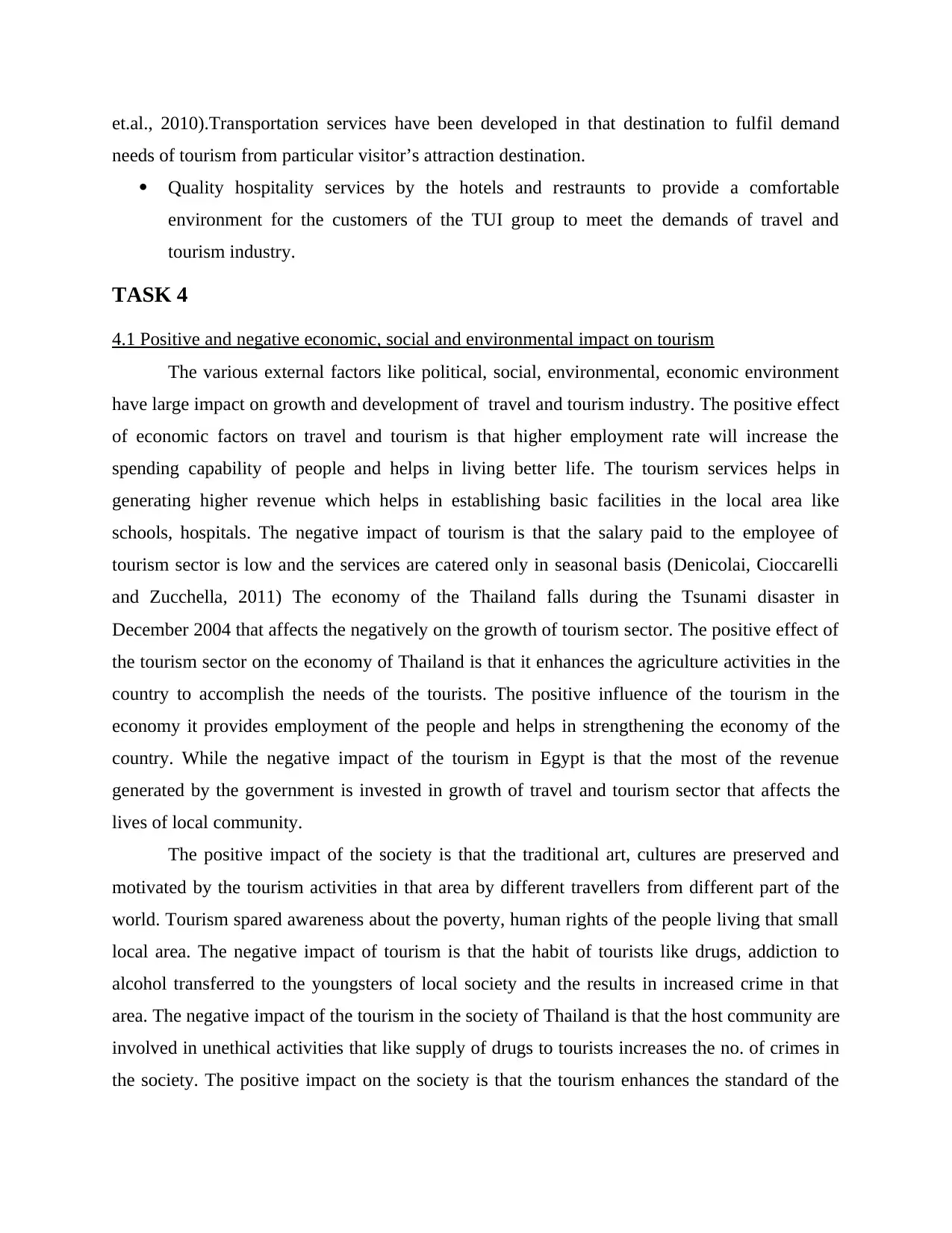
et.al., 2010).Transportation services have been developed in that destination to fulfil demand
needs of tourism from particular visitor’s attraction destination.
Quality hospitality services by the hotels and restraunts to provide a comfortable
environment for the customers of the TUI group to meet the demands of travel and
tourism industry.
TASK 4
4.1 Positive and negative economic, social and environmental impact on tourism
The various external factors like political, social, environmental, economic environment
have large impact on growth and development of travel and tourism industry. The positive effect
of economic factors on travel and tourism is that higher employment rate will increase the
spending capability of people and helps in living better life. The tourism services helps in
generating higher revenue which helps in establishing basic facilities in the local area like
schools, hospitals. The negative impact of tourism is that the salary paid to the employee of
tourism sector is low and the services are catered only in seasonal basis (Denicolai, Cioccarelli
and Zucchella, 2011) The economy of the Thailand falls during the Tsunami disaster in
December 2004 that affects the negatively on the growth of tourism sector. The positive effect of
the tourism sector on the economy of Thailand is that it enhances the agriculture activities in the
country to accomplish the needs of the tourists. The positive influence of the tourism in the
economy it provides employment of the people and helps in strengthening the economy of the
country. While the negative impact of the tourism in Egypt is that the most of the revenue
generated by the government is invested in growth of travel and tourism sector that affects the
lives of local community.
The positive impact of the society is that the traditional art, cultures are preserved and
motivated by the tourism activities in that area by different travellers from different part of the
world. Tourism spared awareness about the poverty, human rights of the people living that small
local area. The negative impact of tourism is that the habit of tourists like drugs, addiction to
alcohol transferred to the youngsters of local society and the results in increased crime in that
area. The negative impact of the tourism in the society of Thailand is that the host community are
involved in unethical activities that like supply of drugs to tourists increases the no. of crimes in
the society. The positive impact on the society is that the tourism enhances the standard of the
needs of tourism from particular visitor’s attraction destination.
Quality hospitality services by the hotels and restraunts to provide a comfortable
environment for the customers of the TUI group to meet the demands of travel and
tourism industry.
TASK 4
4.1 Positive and negative economic, social and environmental impact on tourism
The various external factors like political, social, environmental, economic environment
have large impact on growth and development of travel and tourism industry. The positive effect
of economic factors on travel and tourism is that higher employment rate will increase the
spending capability of people and helps in living better life. The tourism services helps in
generating higher revenue which helps in establishing basic facilities in the local area like
schools, hospitals. The negative impact of tourism is that the salary paid to the employee of
tourism sector is low and the services are catered only in seasonal basis (Denicolai, Cioccarelli
and Zucchella, 2011) The economy of the Thailand falls during the Tsunami disaster in
December 2004 that affects the negatively on the growth of tourism sector. The positive effect of
the tourism sector on the economy of Thailand is that it enhances the agriculture activities in the
country to accomplish the needs of the tourists. The positive influence of the tourism in the
economy it provides employment of the people and helps in strengthening the economy of the
country. While the negative impact of the tourism in Egypt is that the most of the revenue
generated by the government is invested in growth of travel and tourism sector that affects the
lives of local community.
The positive impact of the society is that the traditional art, cultures are preserved and
motivated by the tourism activities in that area by different travellers from different part of the
world. Tourism spared awareness about the poverty, human rights of the people living that small
local area. The negative impact of tourism is that the habit of tourists like drugs, addiction to
alcohol transferred to the youngsters of local society and the results in increased crime in that
area. The negative impact of the tourism in the society of Thailand is that the host community are
involved in unethical activities that like supply of drugs to tourists increases the no. of crimes in
the society. The positive impact on the society is that the tourism enhances the standard of the
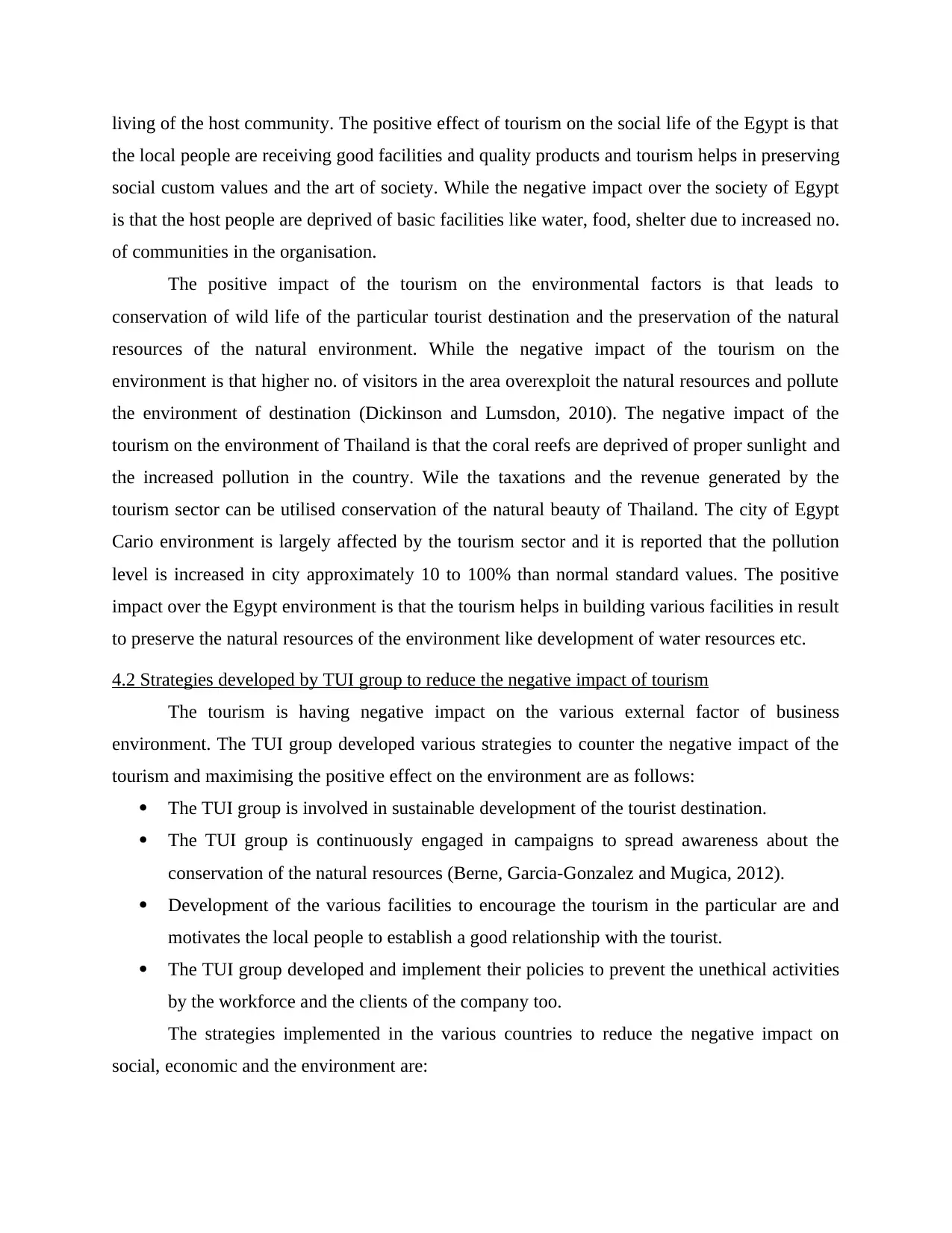
living of the host community. The positive effect of tourism on the social life of the Egypt is that
the local people are receiving good facilities and quality products and tourism helps in preserving
social custom values and the art of society. While the negative impact over the society of Egypt
is that the host people are deprived of basic facilities like water, food, shelter due to increased no.
of communities in the organisation.
The positive impact of the tourism on the environmental factors is that leads to
conservation of wild life of the particular tourist destination and the preservation of the natural
resources of the natural environment. While the negative impact of the tourism on the
environment is that higher no. of visitors in the area overexploit the natural resources and pollute
the environment of destination (Dickinson and Lumsdon, 2010). The negative impact of the
tourism on the environment of Thailand is that the coral reefs are deprived of proper sunlight and
the increased pollution in the country. Wile the taxations and the revenue generated by the
tourism sector can be utilised conservation of the natural beauty of Thailand. The city of Egypt
Cario environment is largely affected by the tourism sector and it is reported that the pollution
level is increased in city approximately 10 to 100% than normal standard values. The positive
impact over the Egypt environment is that the tourism helps in building various facilities in result
to preserve the natural resources of the environment like development of water resources etc.
4.2 Strategies developed by TUI group to reduce the negative impact of tourism
The tourism is having negative impact on the various external factor of business
environment. The TUI group developed various strategies to counter the negative impact of the
tourism and maximising the positive effect on the environment are as follows:
The TUI group is involved in sustainable development of the tourist destination.
The TUI group is continuously engaged in campaigns to spread awareness about the
conservation of the natural resources (Berne, Garcia-Gonzalez and Mugica, 2012).
Development of the various facilities to encourage the tourism in the particular are and
motivates the local people to establish a good relationship with the tourist.
The TUI group developed and implement their policies to prevent the unethical activities
by the workforce and the clients of the company too.
The strategies implemented in the various countries to reduce the negative impact on
social, economic and the environment are:
the local people are receiving good facilities and quality products and tourism helps in preserving
social custom values and the art of society. While the negative impact over the society of Egypt
is that the host people are deprived of basic facilities like water, food, shelter due to increased no.
of communities in the organisation.
The positive impact of the tourism on the environmental factors is that leads to
conservation of wild life of the particular tourist destination and the preservation of the natural
resources of the natural environment. While the negative impact of the tourism on the
environment is that higher no. of visitors in the area overexploit the natural resources and pollute
the environment of destination (Dickinson and Lumsdon, 2010). The negative impact of the
tourism on the environment of Thailand is that the coral reefs are deprived of proper sunlight and
the increased pollution in the country. Wile the taxations and the revenue generated by the
tourism sector can be utilised conservation of the natural beauty of Thailand. The city of Egypt
Cario environment is largely affected by the tourism sector and it is reported that the pollution
level is increased in city approximately 10 to 100% than normal standard values. The positive
impact over the Egypt environment is that the tourism helps in building various facilities in result
to preserve the natural resources of the environment like development of water resources etc.
4.2 Strategies developed by TUI group to reduce the negative impact of tourism
The tourism is having negative impact on the various external factor of business
environment. The TUI group developed various strategies to counter the negative impact of the
tourism and maximising the positive effect on the environment are as follows:
The TUI group is involved in sustainable development of the tourist destination.
The TUI group is continuously engaged in campaigns to spread awareness about the
conservation of the natural resources (Berne, Garcia-Gonzalez and Mugica, 2012).
Development of the various facilities to encourage the tourism in the particular are and
motivates the local people to establish a good relationship with the tourist.
The TUI group developed and implement their policies to prevent the unethical activities
by the workforce and the clients of the company too.
The strategies implemented in the various countries to reduce the negative impact on
social, economic and the environment are:
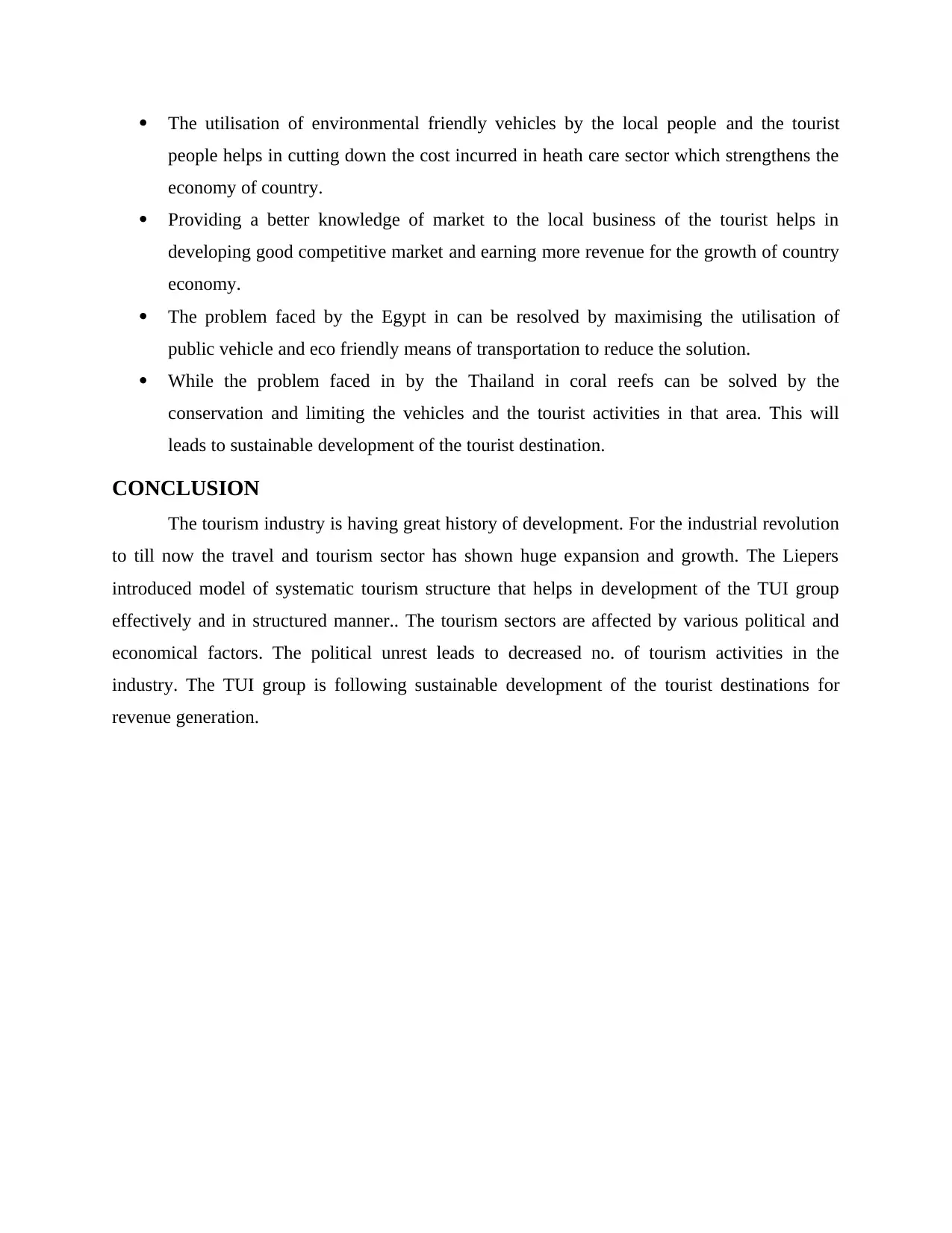
The utilisation of environmental friendly vehicles by the local people and the tourist
people helps in cutting down the cost incurred in heath care sector which strengthens the
economy of country.
Providing a better knowledge of market to the local business of the tourist helps in
developing good competitive market and earning more revenue for the growth of country
economy.
The problem faced by the Egypt in can be resolved by maximising the utilisation of
public vehicle and eco friendly means of transportation to reduce the solution.
While the problem faced in by the Thailand in coral reefs can be solved by the
conservation and limiting the vehicles and the tourist activities in that area. This will
leads to sustainable development of the tourist destination.
CONCLUSION
The tourism industry is having great history of development. For the industrial revolution
to till now the travel and tourism sector has shown huge expansion and growth. The Liepers
introduced model of systematic tourism structure that helps in development of the TUI group
effectively and in structured manner.. The tourism sectors are affected by various political and
economical factors. The political unrest leads to decreased no. of tourism activities in the
industry. The TUI group is following sustainable development of the tourist destinations for
revenue generation.
people helps in cutting down the cost incurred in heath care sector which strengthens the
economy of country.
Providing a better knowledge of market to the local business of the tourist helps in
developing good competitive market and earning more revenue for the growth of country
economy.
The problem faced by the Egypt in can be resolved by maximising the utilisation of
public vehicle and eco friendly means of transportation to reduce the solution.
While the problem faced in by the Thailand in coral reefs can be solved by the
conservation and limiting the vehicles and the tourist activities in that area. This will
leads to sustainable development of the tourist destination.
CONCLUSION
The tourism industry is having great history of development. For the industrial revolution
to till now the travel and tourism sector has shown huge expansion and growth. The Liepers
introduced model of systematic tourism structure that helps in development of the TUI group
effectively and in structured manner.. The tourism sectors are affected by various political and
economical factors. The political unrest leads to decreased no. of tourism activities in the
industry. The TUI group is following sustainable development of the tourist destinations for
revenue generation.
Paraphrase This Document
Need a fresh take? Get an instant paraphrase of this document with our AI Paraphraser

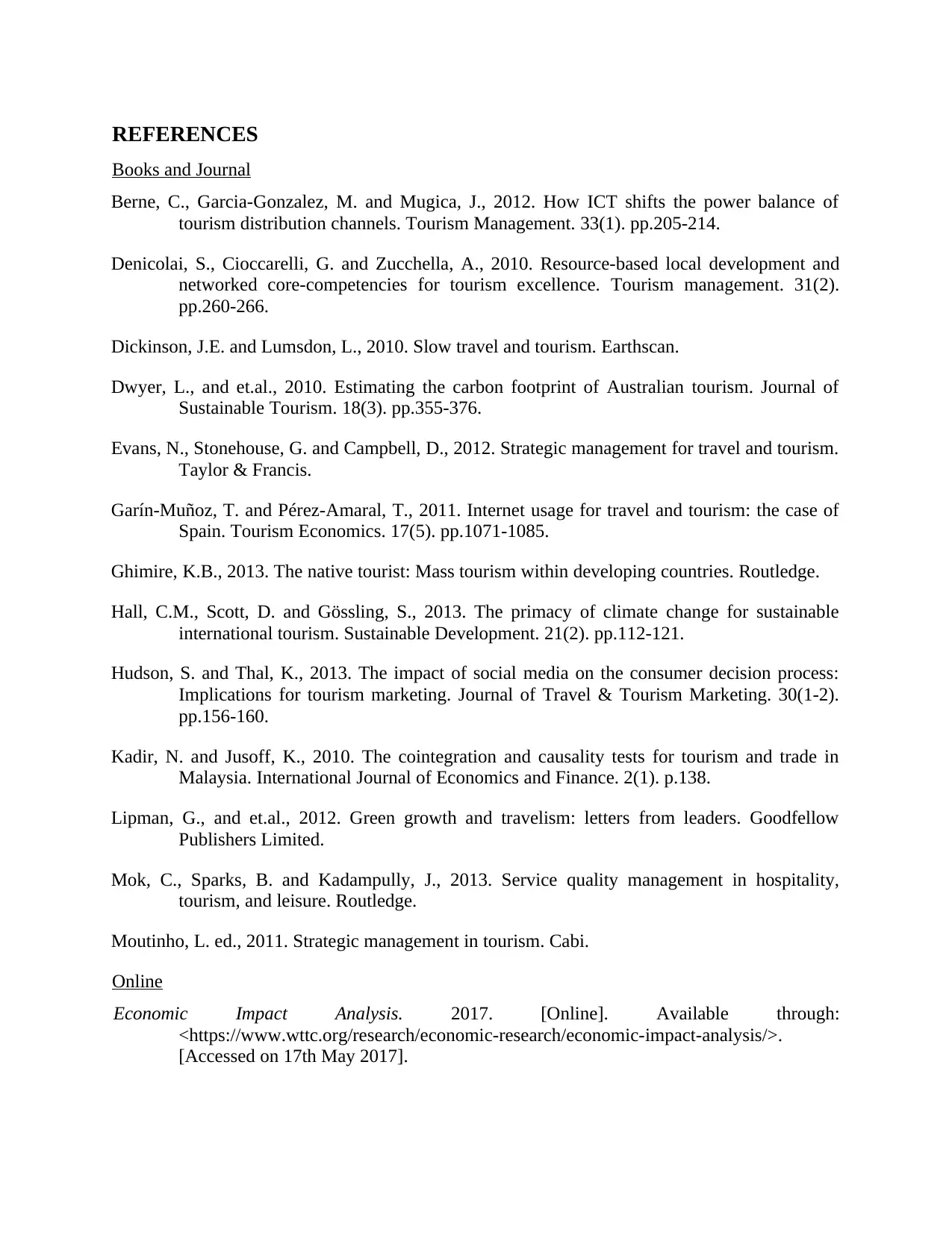
REFERENCES
Books and Journal
Berne, C., Garcia-Gonzalez, M. and Mugica, J., 2012. How ICT shifts the power balance of
tourism distribution channels. Tourism Management. 33(1). pp.205-214.
Denicolai, S., Cioccarelli, G. and Zucchella, A., 2010. Resource-based local development and
networked core-competencies for tourism excellence. Tourism management. 31(2).
pp.260-266.
Dickinson, J.E. and Lumsdon, L., 2010. Slow travel and tourism. Earthscan.
Dwyer, L., and et.al., 2010. Estimating the carbon footprint of Australian tourism. Journal of
Sustainable Tourism. 18(3). pp.355-376.
Evans, N., Stonehouse, G. and Campbell, D., 2012. Strategic management for travel and tourism.
Taylor & Francis.
Garín-Muñoz, T. and Pérez-Amaral, T., 2011. Internet usage for travel and tourism: the case of
Spain. Tourism Economics. 17(5). pp.1071-1085.
Ghimire, K.B., 2013. The native tourist: Mass tourism within developing countries. Routledge.
Hall, C.M., Scott, D. and Gössling, S., 2013. The primacy of climate change for sustainable
international tourism. Sustainable Development. 21(2). pp.112-121.
Hudson, S. and Thal, K., 2013. The impact of social media on the consumer decision process:
Implications for tourism marketing. Journal of Travel & Tourism Marketing. 30(1-2).
pp.156-160.
Kadir, N. and Jusoff, K., 2010. The cointegration and causality tests for tourism and trade in
Malaysia. International Journal of Economics and Finance. 2(1). p.138.
Lipman, G., and et.al., 2012. Green growth and travelism: letters from leaders. Goodfellow
Publishers Limited.
Mok, C., Sparks, B. and Kadampully, J., 2013. Service quality management in hospitality,
tourism, and leisure. Routledge.
Moutinho, L. ed., 2011. Strategic management in tourism. Cabi.
Online
Economic Impact Analysis. 2017. [Online]. Available through:
<https://www.wttc.org/research/economic-research/economic-impact-analysis/>.
[Accessed on 17th May 2017].
Books and Journal
Berne, C., Garcia-Gonzalez, M. and Mugica, J., 2012. How ICT shifts the power balance of
tourism distribution channels. Tourism Management. 33(1). pp.205-214.
Denicolai, S., Cioccarelli, G. and Zucchella, A., 2010. Resource-based local development and
networked core-competencies for tourism excellence. Tourism management. 31(2).
pp.260-266.
Dickinson, J.E. and Lumsdon, L., 2010. Slow travel and tourism. Earthscan.
Dwyer, L., and et.al., 2010. Estimating the carbon footprint of Australian tourism. Journal of
Sustainable Tourism. 18(3). pp.355-376.
Evans, N., Stonehouse, G. and Campbell, D., 2012. Strategic management for travel and tourism.
Taylor & Francis.
Garín-Muñoz, T. and Pérez-Amaral, T., 2011. Internet usage for travel and tourism: the case of
Spain. Tourism Economics. 17(5). pp.1071-1085.
Ghimire, K.B., 2013. The native tourist: Mass tourism within developing countries. Routledge.
Hall, C.M., Scott, D. and Gössling, S., 2013. The primacy of climate change for sustainable
international tourism. Sustainable Development. 21(2). pp.112-121.
Hudson, S. and Thal, K., 2013. The impact of social media on the consumer decision process:
Implications for tourism marketing. Journal of Travel & Tourism Marketing. 30(1-2).
pp.156-160.
Kadir, N. and Jusoff, K., 2010. The cointegration and causality tests for tourism and trade in
Malaysia. International Journal of Economics and Finance. 2(1). p.138.
Lipman, G., and et.al., 2012. Green growth and travelism: letters from leaders. Goodfellow
Publishers Limited.
Mok, C., Sparks, B. and Kadampully, J., 2013. Service quality management in hospitality,
tourism, and leisure. Routledge.
Moutinho, L. ed., 2011. Strategic management in tourism. Cabi.
Online
Economic Impact Analysis. 2017. [Online]. Available through:
<https://www.wttc.org/research/economic-research/economic-impact-analysis/>.
[Accessed on 17th May 2017].
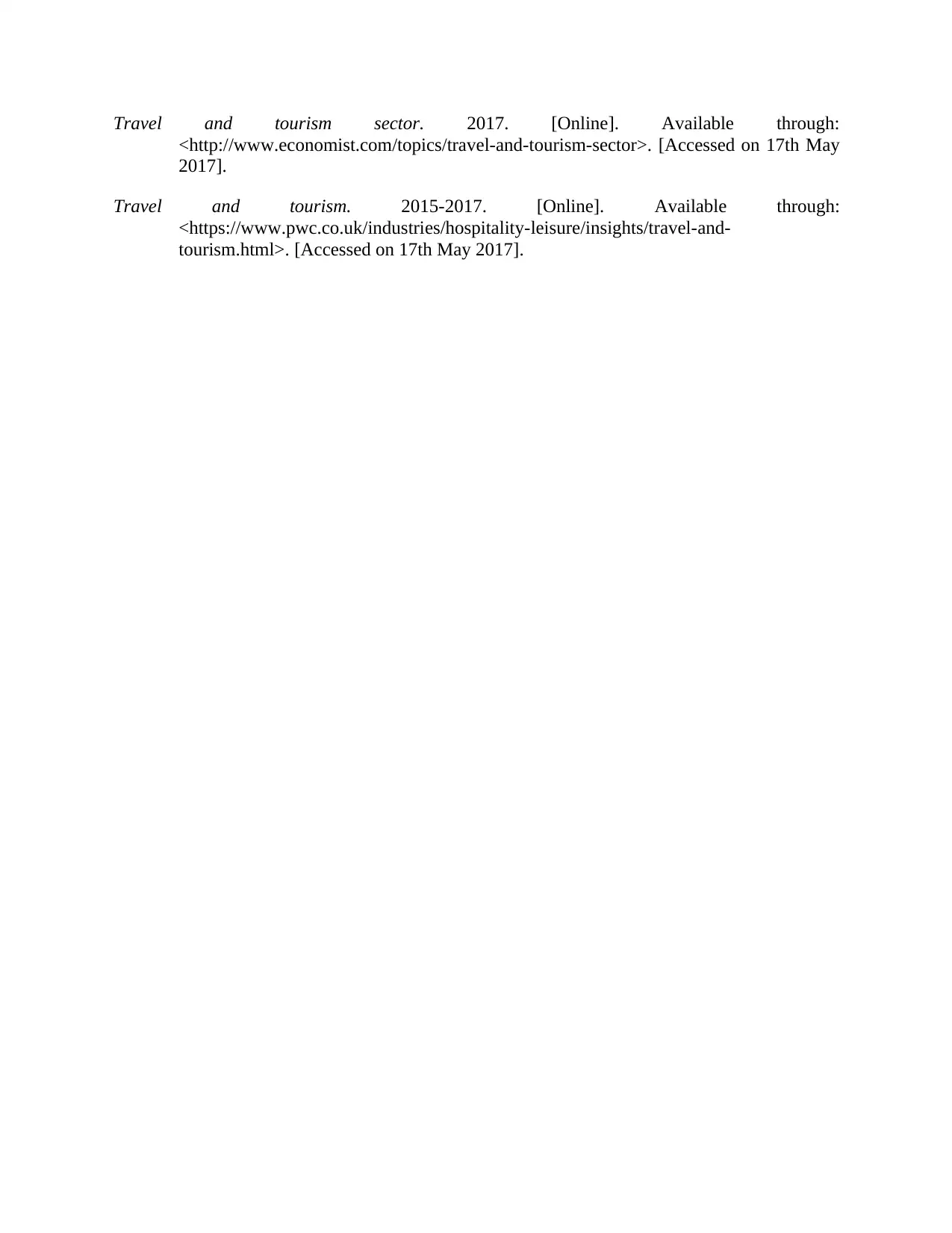
Travel and tourism sector. 2017. [Online]. Available through:
<http://www.economist.com/topics/travel-and-tourism-sector>. [Accessed on 17th May
2017].
Travel and tourism. 2015-2017. [Online]. Available through:
<https://www.pwc.co.uk/industries/hospitality-leisure/insights/travel-and-
tourism.html>. [Accessed on 17th May 2017].
<http://www.economist.com/topics/travel-and-tourism-sector>. [Accessed on 17th May
2017].
Travel and tourism. 2015-2017. [Online]. Available through:
<https://www.pwc.co.uk/industries/hospitality-leisure/insights/travel-and-
tourism.html>. [Accessed on 17th May 2017].
1 out of 10
Related Documents
Your All-in-One AI-Powered Toolkit for Academic Success.
+13062052269
info@desklib.com
Available 24*7 on WhatsApp / Email
![[object Object]](/_next/static/media/star-bottom.7253800d.svg)
Unlock your academic potential
© 2024 | Zucol Services PVT LTD | All rights reserved.





